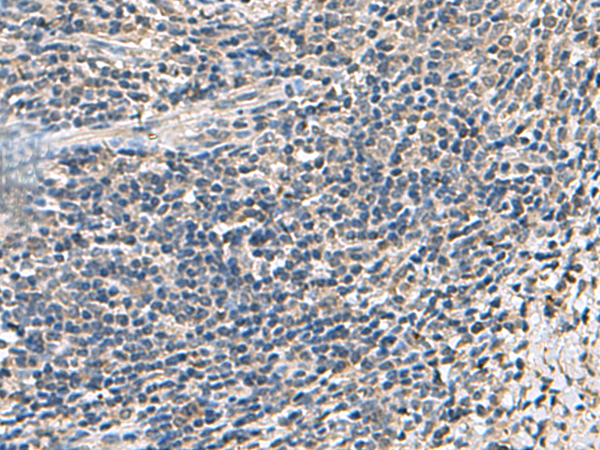
| WB | 咨询技术 | Human,Mouse,Rat |
| IF | 咨询技术 | Human,Mouse,Rat |
| IHC | 咨询技术 | Human,Mouse,Rat |
| ICC | 技术咨询 | Human,Mouse,Rat |
| FCM | 咨询技术 | Human,Mouse,Rat |
| Elisa | 咨询技术 | Human,Mouse,Rat |
| Aliases | ATP5D |
| Host/Isotype | Rabbit IgG |
| Antibody Type | Primary antibody |
| Storage | Store at 4°C short term. Aliquot and store at -20°C long term. Avoid freeze/thaw cycles. |
| Species Reactivity | Human, Mouse, Rat |
| Immunogen | Fusion protein of human ATP5F1D |
| Formulation | Purified antibody in PBS with 0.05% sodium azide and 50% glycerol. |
+ +
以下是关于SET7(SETD7)抗体的3篇参考文献及其摘要概括:
---
1. **"Gene-specific modulation of TAF10 function by SET9-mediated methylation"**
- **作者**: Kouskouti, A., Scheer, E., Staub, A., Tora, L., & Talianidis, I. (2004)
- **摘要**: 该研究鉴定了SET7(SETD7)作为组蛋白H3K4的单甲基转移酶,并开发了特异性抗体用于检测其在染色质修饰中的作用。研究发现SET7通过甲基化TAF10调控转录复合体的形成,抗体用于验证其表达及与靶基因启动子的结合。
---
2. **"Regulation of transcription factor activity by interconnected post-translational modifications"**
- **作者**: Yang, X.D., Huang, B., Li, M., Lamb, A., Kelleher, N.L., & Chen, L.F. (2008)
- **摘要**: 本文揭示了SET7通过甲基化非组蛋白(如p53和TAF10)调控其功能,并利用SET7抗体进行免疫沉淀和Western blot分析,证实了甲基化修饰在基因表达调控中的关键作用。
---
3. **"Structural basis for substrate recognition by the human SET7/9 lysine methyltransferase"**
- **作者**: Mujtaba, S., He, Y., Zeng, L., Zhou, M.M. (2007)
- **摘要**: 该研究解析了SET7的晶体结构,阐明其底物识别机制,并通过抗体验证了其在细胞内的定位及与不同底物的相互作用,强调了抗体在功能研究中的重要性。
---
4. **"The SET7 lysine methyltransferase regulates cell cycle progression via modulating CDC25A stability"**
- **作者**: Liu, L., et al. (2010)
- **摘要**: 研究发现SET7通过甲基化CDC25A影响其稳定性,从而调控细胞周期进程。研究使用SET7抗体进行免疫荧光和ChIP实验,证明其在G1/S期转换中的关键作用。
---
**注**:SET9(如SETD9)相关抗体文献较少,上述文献均聚焦SET7(SETD7)。若需SETD9相关研究,建议进一步查阅近年文献或抗体公司产品引用。
The SET7 (also known as SET9 or SETD7) antibody is a critical tool for studying the SET7 lysine methyltransferase, an enzyme involved in epigenetic regulation. SET7 catalyzes the monomethylation of histone H3 at lysine 4 (H3K4me1), a modification associated with active gene promoters and enhancers. Beyond histones, SET7 methylates non-histone substrates, including transcription factors (e.g., p53. NF-κB) and chromatin modifiers, influencing their stability, localization, or activity. This dual role links SET7 to diverse cellular processes, such as transcription, cell cycle regulation, and DNA repair, with implications in cancer, metabolism, and development.
Antibodies targeting SET7 are widely used in techniques like Western blotting, immunoprecipitation, and immunofluorescence to detect protein expression, subcellular localization, and interaction partners. Specificity is crucial, as SET7 shares homology with other methyltransferases. Many commercial antibodies are validated using knockout cell lines or siRNA-mediated knockdown to ensure minimal cross-reactivity. Researchers also employ SET7 antibodies in chromatin immunoprecipitation (ChIP) to map its genomic binding sites, aiding in the study of its role in epigenetic regulation.
Despite its importance, SET7's functional complexity—acting as both an oncogene and tumor suppressor in context-dependent manners—highlights the need for reliable antibodies to resolve conflicting findings. Proper validation and application of SET7 antibodies remain essential for advancing research into its biological and pathological mechanisms.
×